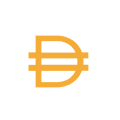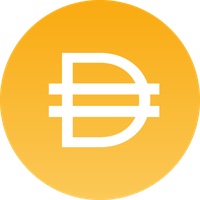𝐃𝐀𝐈 𝐢𝐬𝐭 𝐞𝐢𝐧 𝐒𝐭𝐚𝐛𝐥𝐞𝐜𝐨𝐢𝐧 𝐠𝐞𝐠𝐞𝐧 𝐔𝐒𝐃, 𝐚𝐥𝐥𝐞𝐫𝐝𝐢𝐧𝐠𝐬 𝐨𝐡𝐧𝐞 𝐔𝐒𝐃-𝐑ü𝐜𝐤𝐥𝐚𝐠𝐞𝐧 - unlike Tether or Binance USD. Sound wyld? Let's see if it does.
If you don't know what a stablecoin is, I recommend you read the post by @Europoor
https://app.getquin.com/activity/ZbyIuQLbvP.
The most popular USD stablecoins store one USD for each issued coin in a bank account, which is supposed to ensure that a USD stablecoin can be exchanged for a real USD 1:1 at any time. At least that is what the issuers of these stablecoins claim. You have to trust the statements of a central organization here, which in the best case is controlled by another central organization. To me, this sounds very much like problems (trust in individual players, centralization) that crypto would actually like to replace.
DAI also tries to map the USD exchange rate 1:1, but no USD are bunkered anywhere for this.
𝐖𝐢𝐞 𝐟𝐮𝐧𝐤𝐭𝐢𝐨𝐧𝐢𝐞𝐫𝐭 𝐃𝐀𝐈 𝐝𝐚𝐧𝐧?
For each DAI generated, other coins / tokens are deposited as so-called collaterals in Vaults. This means that you deposit e.g. ETH as collateral and receive a certain amount of DAI in exchange. If you want your ETH back, you have to pay back the DAI you received and a fee. Originally, only ETH could be deposited as collateral, but now other coins/tokens are also possible. Technically, this is realized via smart contracts.
𝐖𝐢𝐞 𝐯𝐢𝐞𝐥 𝐃𝐀𝐈 𝐞𝐫𝐡𝐚𝐥𝐭𝐞 𝐢𝐜𝐡 𝐟ü𝐫 𝐦𝐞𝐢𝐧 𝐂𝐨𝐥𝐥𝐚𝐭𝐞𝐫𝐚𝐥?
This depends on the USD rate of the collateral deposited as well as the risk associated with the collateral. For example, roughly for 1.5 USD in ETH you get 1 DAI. This is one of several safety mechanisms to prevent the value of the collateral from falling below the value of the issued DAI in the short term due to exchange rate fluctuations. So if an ETH is worth 3,000 USD, you will receive 2,000 DAI for it. Of course, you only have to pay back the 2,000 DAI + fee to redeem your ETH.
𝐖𝐚𝐬 𝐩𝐚𝐬𝐬𝐢𝐞𝐫𝐭, 𝐰𝐞𝐧𝐧 𝐝𝐞𝐫 𝐖𝐞𝐫𝐭 𝐦𝐞𝐢𝐧𝐞𝐬 𝐂𝐨𝐥𝐥𝐚𝐭𝐞𝐫𝐚𝐥𝐬 𝐬𝐭𝐚𝐫𝐤 𝐬𝐢𝐧𝐤𝐭?
Volatility is nothing unusual in the crypto world, accordingly, it is quite possible that the value of the collateral drops sharply. If necessary, even to such an extent that the value of the generated DAI becomes higher than that of the deposited collateral. To counteract this, the collateral is liquidated at a certain point in time, depending on certain risk parameters such as volatility. The exact process is a bit more complicated, an explanation would go beyond the scope here. Interested parties can find the details here: https://makerdao.com/en/whitepaper/#maker-vaults
𝐖𝐞𝐥𝐜𝐡𝐞 𝐰𝐞𝐢𝐭𝐞𝐫𝐞𝐧 𝐌𝐞𝐜𝐡𝐚𝐧𝐢𝐬𝐦𝐞𝐧 𝐠𝐢𝐛𝐭 𝐞𝐬, 𝐮𝐦 𝐝𝐞𝐧 𝐏𝐫𝐞𝐢𝐬 𝐬𝐭𝐚𝐛𝐢𝐥 𝐛𝐞𝐢 𝐞𝐢𝐧𝐞𝐦 𝐔𝐒𝐃 𝐳𝐮 𝐡𝐚𝐥𝐭𝐞𝐧?
In addition, there are so-called keepers that automatically sell DAI should the price be above 1 USD or buy should the price be below 1 USD.
𝐊𝐚𝐧𝐧 𝐦𝐚𝐧 𝐃𝐀𝐈 𝐚𝐮𝐜𝐡 𝐨𝐡𝐧𝐞 𝐕𝐚𝐮𝐥𝐭𝐬 𝐮𝐧𝐝 𝐂𝐨𝐥𝐥𝐚𝐭𝐞𝐫𝐚𝐥 (𝐛𝐞𝐢 𝐊𝐫𝐲𝐩𝐭𝐨𝐛ö𝐫𝐬𝐞𝐧) 𝐤𝐚𝐮𝐟𝐞𝐧?
If you want to use DAI, e.g. because you consider it more secure than Tether, Binance USD & Co, you can also buy DAI like any other cryptocurrency on crypto exchanges like Binance.
𝐔𝐧𝐝 𝐰𝐚𝐬 𝐤𝐚𝐧𝐧 𝐢𝐜𝐡 𝐬𝐨𝐧𝐬𝐭 𝐧𝐨𝐜𝐡 𝐬𝐨 𝐦𝐢𝐭 𝐃𝐀𝐈 𝐦𝐚𝐜𝐡𝐞𝐧?
Like other stablecoins, DAI can also be used for DeFi. For example, in liquidity pools. Otherwise, you can also leverage your collateral with it. If you have 3,000 USD in ETH and deposit it as collateral, you will receive 2,000 DAI, which you can exchange for 2,000 USD in ETH. You then deposit these again as collateral for 1,333 DAI. You then exchange the 1,333 DAI again for ETH and deposit them again as collateral for 888 DAI, and so on.
𝐈𝐬𝐭 𝐃𝐀𝐈 𝐚𝐮𝐬 𝐞𝐮𝐫𝐞𝐫 𝐒𝐢𝐜𝐡𝐭 𝐞𝐢𝐧𝐞 (𝐛𝐞𝐬𝐬𝐞𝐫𝐞) 𝐀𝐥𝐭𝐞𝐫𝐧𝐚𝐭𝐢𝐯𝐞 𝐳𝐮 𝐚𝐧𝐝𝐞𝐫𝐞𝐧 𝐔𝐒𝐃-𝐒𝐭𝐚𝐛𝐥𝐞𝐜𝐨𝐢𝐧𝐬?
Source + further information: https://makerdao.com/en/whitepaper/#abstract
#stablecoin
#learn
#hebel
#esel
#crypto









